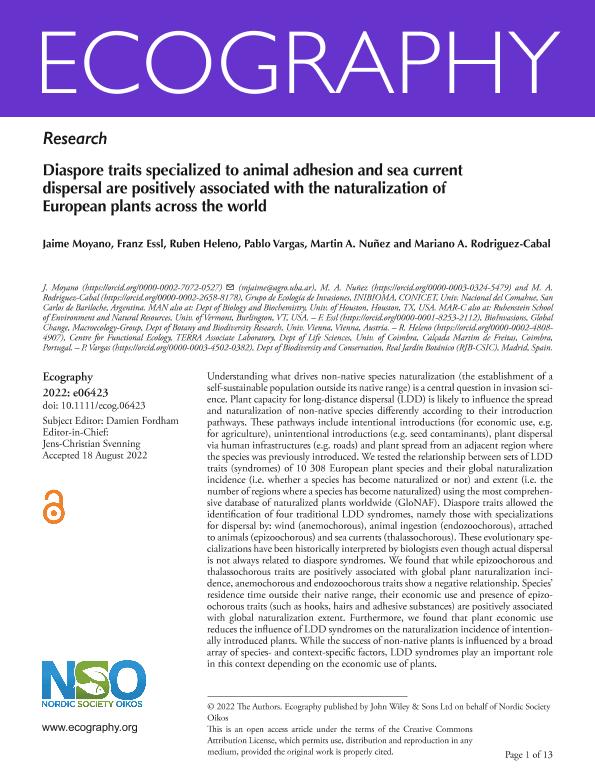Mostrar el registro sencillo del ítem
dc.contributor.author
Moyano, Jaime

dc.contributor.author
Essl, Franz
dc.contributor.author
Heleno, Ruben
dc.contributor.author
Vargas, Pablo
dc.contributor.author
Nuñez, Martin Andres

dc.contributor.author
Rodriguez Cabal, Mariano Alberto

dc.date.available
2023-07-18T20:19:14Z
dc.date.issued
2022-11
dc.identifier.citation
Moyano, Jaime; Essl, Franz; Heleno, Ruben; Vargas, Pablo; Nuñez, Martin Andres; et al.; Diaspore traits specialized to animal adhesion and sea current dispersal are positively associated with the naturalization of European plants across the world; Wiley Blackwell Publishing, Inc; Ecography; 2022; 11; 11-2022; 1-13
dc.identifier.issn
0906-7590
dc.identifier.uri
http://hdl.handle.net/11336/204332
dc.description.abstract
Understanding what drives non-native species naturalization (the establishment of a self-sustainable population outside its native range) is a central question in invasion science. Plant capacity for long-distance dispersal (LDD) is likely to influence the spread and naturalization of non-native species differently according to their introduction pathways. These pathways include intentional introductions (for economic use, e.g. for agriculture), unintentional introductions (e.g. seed contaminants), plant dispersal via human infrastructures (e.g. roads) and plant spread from an adjacent region where the species was previously introduced. We tested the relationship between sets of LDD traits (syndromes) of 10 308 European plant species and their global naturalization incidence (i.e. whether a species has become naturalized or not) and extent (i.e. the number of regions where a species has become naturalized) using the most comprehensive database of naturalized plants worldwide (GloNAF). Diaspore traits allowed the identification of four traditional LDD syndromes, namely those with specializations for dispersal by: wind (anemochorous), animal ingestion (endozoochorous), attached to animals (epizoochorous) and sea currents (thalassochorous). These evolutionary specializations have been historically interpreted by biologists even though actual dispersal is not always related to diaspore syndromes. We found that while epizoochorous and thalassochorous traits are positively associated with global plant naturalization incidence, anemochorous and endozoochorous traits show a negative relationship. Species' residence time outside their native range, their economic use and presence of epizoochorous traits (such as hooks, hairs and adhesive substances) are positively associated with global naturalization extent. Furthermore, we found that plant economic use reduces the influence of LDD syndromes on the naturalization incidence of intentionally introduced plants. While the success of non-native plants is influenced by a broad array of species- and context-specific factors, LDD syndromes play an important role in this context depending on the economic use of plants.
dc.format
application/pdf
dc.language.iso
eng
dc.publisher
Wiley Blackwell Publishing, Inc

dc.rights
info:eu-repo/semantics/openAccess
dc.rights.uri
https://creativecommons.org/licenses/by/2.5/ar/
dc.subject
BIOTIC INVASIONS
dc.subject
DIASPORE TRAITS
dc.subject
DISPERSAL SYNDROMES
dc.subject
GLOBAL PLANT NATURALIZATION
dc.subject
NON-NATIVE PLANTS
dc.subject
PLANT ECONOMIC USE
dc.subject.classification
Ecología

dc.subject.classification
Ciencias Biológicas

dc.subject.classification
CIENCIAS NATURALES Y EXACTAS

dc.title
Diaspore traits specialized to animal adhesion and sea current dispersal are positively associated with the naturalization of European plants across the world
dc.type
info:eu-repo/semantics/article
dc.type
info:ar-repo/semantics/artículo
dc.type
info:eu-repo/semantics/publishedVersion
dc.date.updated
2023-06-29T10:24:00Z
dc.identifier.eissn
1600-0587
dc.journal.volume
2022
dc.journal.number
11
dc.journal.pagination
1-13
dc.journal.pais
Reino Unido

dc.journal.ciudad
Londres
dc.description.fil
Fil: Moyano, Jaime. Consejo Nacional de Investigaciones Científicas y Técnicas. Centro Científico Tecnológico Conicet - Patagonia Norte. Instituto de Investigaciones en Biodiversidad y Medioambiente. Universidad Nacional del Comahue. Centro Regional Universidad Bariloche. Instituto de Investigaciones en Biodiversidad y Medioambiente; Argentina
dc.description.fil
Fil: Essl, Franz. Universidad de Viena; Austria
dc.description.fil
Fil: Heleno, Ruben. Universidad de Coimbra; Portugal
dc.description.fil
Fil: Vargas, Pablo. Consejo Superior de Investigaciones Científicas. Real Jardín Botánico; España
dc.description.fil
Fil: Nuñez, Martin Andres. Consejo Nacional de Investigaciones Científicas y Técnicas. Centro Científico Tecnológico Conicet - Patagonia Norte. Instituto de Investigaciones en Biodiversidad y Medioambiente. Universidad Nacional del Comahue. Centro Regional Universidad Bariloche. Instituto de Investigaciones en Biodiversidad y Medioambiente; Argentina. University Of Houston; Estados Unidos
dc.description.fil
Fil: Rodriguez Cabal, Mariano Alberto. Consejo Nacional de Investigaciones Científicas y Técnicas. Centro Científico Tecnológico Conicet - Patagonia Norte. Instituto de Investigaciones en Biodiversidad y Medioambiente. Universidad Nacional del Comahue. Centro Regional Universidad Bariloche. Instituto de Investigaciones en Biodiversidad y Medioambiente; Argentina. University of Vermont; Estados Unidos
dc.journal.title
Ecography

dc.relation.alternativeid
info:eu-repo/semantics/altIdentifier/url/https://onlinelibrary.wiley.com/doi/10.1111/ecog.06423
dc.relation.alternativeid
info:eu-repo/semantics/altIdentifier/doi/http://dx.doi.org/doi: 10.1111/ecog.06423
Archivos asociados
